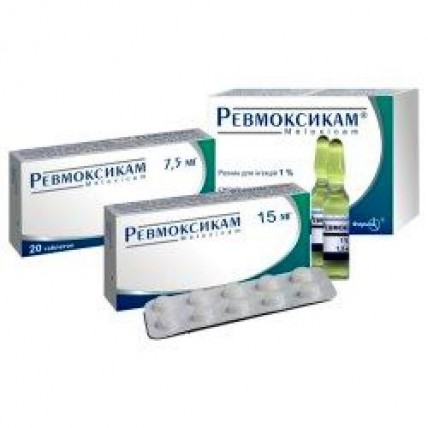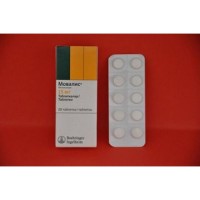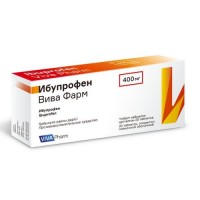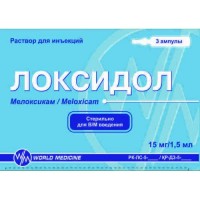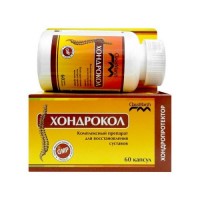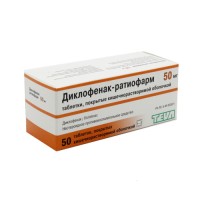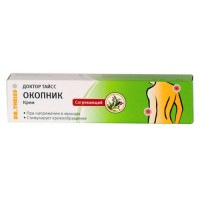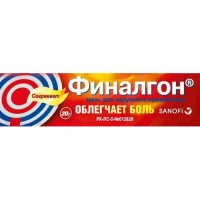Revmoksikam® 1% / 1.5 ml 5's solution for injection in ampoules
- $18.90
The instruction for medical use
of REVMOKSIKAM® medicine
the Trade name
of Revmoksikam®
the International unlicensed
name Meloksikam Lekarstvennaya a form
Solution for injections of 1% 1.5 ml
Structure
of 1 ml of drug contains
active agent: a meloksikama in terms of 100% substance of 10 mg,
excipients: Megluminum (N – methylglucamine), glycine, half-oxameasures 188, glikofurol, sodium chloride, 0.1 M hydroxide sodium solution, water for injections.
Description
Transparent yellow or chartreuse liquid.
Pharmacotherapeutic group
Non-steroidal anti-inflammatory drugs. Oksikama.
Meloksikam.
The ATX M01AC06 code
the Pharmacological
Meloksikam Pharmacokinetics properties is completely absorbed after an intramuscular injection that displays absolute bioavailability (nearly 100%).
The pharmacokinetics of a meloksikam is linear also a dozozavisima at intramuscular use of 7.5 mg and 15 mg. Concentration of a meloksikam in blood plasma reaches peak in 60 minutes after an intramuscular injection. Stable concentration are reached for 3-5 days. Continuous treatment throughout the long period (for example, 6 months) did not lead to changes of pharmacokinetic parameters, in comparison with parameters after 2 weeks of oral introduction of a meloksikam on 15 mg a day.
Any changes are also improbable also lasting treatment more than 6 months.
In blood more than 99% contact proteins of plasma (mainly with albumine). Meloksikam gets into synovial fluid in concentration approximately twice smaller, than in blood plasma.
Meloksikam is subject to extensive biotransformation in a liver. Meloksikam is almost completely metabolized to four pharmacological inert metabolites. The main metabolite, 5 '-karboksimeloksikam (60% of a dose) is formed by oxidation of an intermediate metabolite 5 '-hydroksimetilmeloksikama that is also allocated in a smaller measure (9% of a dose). The researches in vitro assume that CYP 2C9 plays an important role in the course of metabolism whereas CYP 3A4 isoenzymes to a lesser extent. The activity of peroxidase at patients, perhaps, is responsible for two other metabolites which make 16% and 4% of the appointed dose respectively.
It is excreted to meloksika mainly in the form of metabolites with urine and a stake in identical quantity. Less than 5% of a daily dose are allocated not changed in kcal whereas traces of not changed components are allocated in urine. Elimination half-life makes about 20 hours. A liver and renal failure significantly do not influence pharmacokinetics of a meloksikam. The plasma clearance is 8 ml/min. The clearance decreases at women of advanced age. Distribution volume low, on average 11 l. Individual deviations make 30-40% after intramuscular use.
The pharmacodynamics
of Revmoksikam® is a non-steroidal anti-inflammatory drug (NPVS) of a class of enolovy acid, has anti-inflammatory, analgetic and antipyretic effect. The general mechanism of the listed effects can consist in ability of Revmoksikama® to inhibit biosynthesis of prostaglandins – inflammation mediators.
Safer mechanism of action Revmoksikama® is connected with selection inhibition of cyclooxygenase-2 (TsOG-2) in comparison with cyclooxygenase-1 (TsOG-1). For today it is obvious that the therapeutic effect of NPVS is connected with inhibition of synthesis of TsOG-2 whereas the inhibition of TsOG-1 results in side effects from a stomach and kidneys.
The selectivity of inhibition of TsOG-2 meloksikamy is confirmed with many researches both in vitro, and ex vivo. Meloksikam (7.5 mg and 15 mg) mainly inhibits ex vivo TsOG-2 that is confirmed by big inhibition of products of PGE2 in response to stimulation by lipopolysaccharide, in comparison with products of thromboxane in blood (TsOG-1). These effects of a dozozavisima. Meloksikam does not influence aggregation of thrombocytes or for a bleeding time at use of the recommended ex vivo doses whereas indometacin, diclofenac, an ibuprofen and Naproxenum considerably inhibit aggregation of thrombocytes and extend bleeding.
Clinical trials established the low frequency of gastrointestinal by-effects (perforation, formation of ulcers and bleeding) at use of the recommended doses of a meloksikam in comparison with standard doses of other NPVS.
Indications
Initial and short-term symptomatic treatment
- a pseudorheumatism
- pain in osteoarthrites (arthroses, degenerative diseases of joints)
- an ankylosing spondylitis.
The route of administration and doses
of Revmoksikam® should be entered deeply intramusculary.
The recommended dose makes 7.5-15 mg a day, depending on intensity of pain and weight of inflammation.
The course of treatment depends on the nature of a disease and efficiency of therapy. Intramusculary drug is appointed during the first days of treatment, and then it is necessary to apply an oral form. With increase in a dose and duration of treatment the risk of side reactions therefore it is necessary to apply the smallest effective dose and the shortest course of treatment increases. At the combined use of different dosage forms of drug the general daily dose of a meloksikam should not exceed 15 mg.
At patients with a severe form of a renal failure who are on dialysis the daily dose should not exceed 7.5 mg.
Ревмоксикам® it is impossible to mix in one syringe with other medicines.
Side effects
Very often
- dyspepsia, nausea, vomiting, an abdominal pain, constipations, diarrhea, a meteorism
- an itching, irritation of skin
- slight dizziness, a headache
- hypostases
- anemia
- a hematoma in the place of an injection
is frequent
- sonitus, slackness
- stomatitis, urticaria
- temporary disturbance of indicators of function of a liver (for example, increase in transaminases or bilirubin), an eructation, an esophagitis, a gastroduodenal ulcer, gastrointestinal bleeding
- changes in a blood count, including in a leukocytic formula, a leukopenia and thrombocytopenia. Simultaneous use of potentially myelotoxic drug, especially a methotrexate, can lead ment of a cytopenia
- changes of indicators of function of kidneys (increase in creatinine and/or urea)
- increase in arterial blood pressure, inflows, heart consciousness
- pain in the field of an injection
Seldom
- gastrointestinal perforation, colitis, hepatitis, gastritis. Gastrointestinal bleeding, an ulcer or perforation can be lethal.
- a photosensitization
- asthma attacks at persons with an allergy to acetylsalicylic acid or to other non-steroidal anti-inflammatory drugs
- confusion of consciousness and a disorientation, change of mood
- an acute renal failure, interstitial nephrite, an albuminuria, a hamaturia. Use of non-steroidal anti-inflammatory drugs can be followed by urination disorders, including a sharp ischuria
- conjunctivitis, visual disturbances that includes illegibility of sight
- a Quincke's disease, anaphylactoid/anaphylactic reactions, including an acute anaphylaxis
In some cases can develop a polymorphic erythema, Stephens-Johnson's syndrome, a toksiko-epidermal necrolysis.
Contraindications
- hypersensitivity to a meloksikam or any other component of drug
- hypersensitivity to acetylsalicylic acid and other non-steroidal anti-inflammatory drugs. Ревмоксикам® patients at whom is in the anamnesis after prescribing of acetylsalicylic acid or other NPVS should not appoint symptoms of bronchial asthma, nasal polyps, a Quincke's disease, a small tortoiseshell were observed
- it is not necessary to appoint to the patients receiving anticoagulants, considering possible risk of developing an intramuscular hematoma
- erosive and ulcer changes mucous a stomach and duodenum/perforation in a phase of aggravation or recently postponed
- nonspecific ulcer colitis in an aggravation phase, Crohn's disease
- the profound liver failure, liver diseases in the acute stage
- gastrointestinal bleeding, recently postponed cerebrovascular bleeding or system disturbances of blood clotting
- the progressing disease of kidneys, the profound renal failure (if the hemodialysis is not carried out), clearance of creatinine less than 30 ml/min.
- dekompensirovanny heart failure
- a postoperative pain syndrome after aortocoronary shunting (imposing of a roundabout anastomosis)
- children's and teenage age up to 18 years
- pregnancy, the lactation period
Medicinal interaction
Other inhibitors of a prostaglandinsintetaza, including glucocorticoids and salicylates (acetylsalicylic acid): non-steroidal anti-inflammatory drugs increase risk of formation of ulcers of digestive tract and bleeding and therefore such combination is not recommended.
Lithium. There are data that NPVS increase the level of concentration of lithium in blood plasma. Control of content of lithium in blood plasma in an initiation of treatment is recommended, at selection of a dose and at the termination of treatment of Revmoksikamom®.
Methotrexate. Ревмоксикам® can increase hematologic toxicity of a methotrexate – it demands serious control, especially when the methotrexate and NPVS appoint 3 days in a row.
Contraception. NPVS reduce efficiency of contraceptives.
Diuretics. Treatment of NPVS of the dehydrated patients is connected with potential risk of developing of an acute renal failure. Therefore before an initiation of treatment it is necessary to check function of kidneys, and further, at simultaneous use of Revmoksikama® and diuretics, patients have to receive adequate amount of liquid.
Antihypertensive drugs (for example, beta blockers, APF inhibitors, vazodilatator, diuretics): it is known that NPVS reduce antihypertensive effect, and it is connected with the inhibiting impact on vazodilatatorny prostaglandins.
NPVS and antagonists of receptors of angiotensin-II and also APF inhibitors show synergy effect on reduction of glomerular filtration. At patients with disturbance of renal function in the anamnesis it can lead to an acute renal failure.
Holestiramin connects to meloksika in digestive tract that accelerates removal of a meloksikam.
NPVS increase nephrotoxicity of cyclosporine because of impact on renal prostaglandins that demands considerable control of function of kidneys at simultaneous use of drugs.
Meloksikam is brought almost completely by hepatic metabolism which about two thirds are reached by means of cytochromes (CYP) of P450 enzymes (CYP the main ways and CYP minor ways) and one third – by means of other ways, such as peroxidase oxidation.
It is necessary to take in attention potential interaction at simultaneous use of a meloksikam and means which are known for ability to inhibit or are metabolized by CYP 2C9 and/or CYP 3A4.
Interaction of Revmoksikama® with antacids, Cimetidinum, digoxin and furosemide at simultaneous use is not revealed.
It is impossible to exclude a possibility of interaction of drug with oral anti-diabetic means.
Use of a meloksikam together with oral anticoagulants, antithrombocytic means, heparin at system introduction, thrombolytic means and also selective serotonin reuptake inhibitors increases risk of bleeding because of slowing down of function of thrombocytes. In case of need such treatment it is recommended to carry out careful observation of the patient.
Special instructions
Patients with gastrointestinal diseases. Patients with gastrointestinal diseases in the anamnesis demand careful medical observation during reception of Revmoksikama®. Potentially lethal gastrointestinal bleeding, an ulcer or perforation can arise in the course of treatment with existence or without the previous symptoms or serious gastrointestinal diseases in the anamnesis at any time. The most serious consequences observed at elderly people.
Reactions from skin. Very seldom during administration of drug serious skin reactions, including exfoliative dermatitis, Stephens-Johnson's syndrome and a toxic epidermal necrolysis were observed. Most often such reactions were shown within the first month of treatment. At appearance of skin rash, damages of mucous membranes or other signs of hypersensitivity it is necessary to stop administration of drug.
Patients with cardiovascular diseases. Non-steroidal anti-inflammatory drugs can increase risk of appearance of thromboses, a myocardial infarction and stroke which can be fatal. At increase in duration of treatment this risk can increase. Such risk can increase at patients with cardiovascular diseases or with risk factors of developing such diseases.
Patients with a renal failure. Use of non-steroidal anti-inflammatory drugs can cause a renal failure in patients with a reduced volume of blood and a reduced renal blood-groove which disappears after drug withdrawal. The greatest risk of emergence of such reaction at patients of advanced age, at patients with dehydration, with stagnant heart failure, at patients with cirrhosis, with a nephrotic syndrome and chronic renal disturbances and also at patients who receive the accompanying therapy with diuretic drugs, APF inhibitors or antagonists of receptors of angiotensin-II, or after volume surgical interventions that led to a hypovolemia. To such patients control of a diuresis and function of kidneys is necessary for therapy in the beginning. In some cases use of non-steroidal anti-inflammatory drugs (NPVS) can cause interstitial nephrite, a glomerulonephritis, renal medullary necrosis or development of a nephrotic syndrome.
Patients with an abnormal liver function. Clinically stable sick cirrhosis the dose of Revmoksikama® does not need to be reduced. In some cases at use of drug the increase in level of transaminases or other parameters of function of a liver is observed. In most cases changes were insignificant and had temporality. At a resistant and essential aberration drug treatment it is necessary to stop and perform examination of the patient.
The weakened patients and patients of advanced age. The weakened patients demand more careful medical observation. It is necessary to use with care drug to patients of advanced age because of risk of depression of function of kidneys, heart and a liver.
Other effects. Meloksikam can mask symptoms of infectious diseases. At use of non-steroidal anti-inflammatory drugs there can be a delay of sodium, potassium and liquid in an organism. Thereof at sensitive patients the heart failure or an arterial hypertension can arise or amplify. Such patients demand careful medical observation.
Fertility. To women who try to become pregnant have problems with fertilization or undergo inspection concerning infertility, it is necessary to consider a question of the termination of administration of drug.
There Is no feature of influence of drug on ability to run transport and potentially dangerous mechanisms data on influence of drug on speed of response, but if there are visual disturbances or side reactions from the central nervous system, it is necessary to refrain from control of motor transport or work with other mechanisms.
Overdose
in case of overdose strengthening of side reactions is possible.
Treatment: symptomatic. There is no specific antidote. There are data that holestiramin increases removal of a meloksikam.
A form of release and packing
On 1.5 ml in ampoules glass with a ring of a break or a point of a break.
On 3 or 5 ampoules put in blister strip packaging from a film polymeric. On 1 blister strip packaging with ampoules together with the instruction for medical use in the state and Russian languages put in a pack from cardboard.
Or on 5 ampoules together with the instruction for medical use in the state and Russian languages put in a pack from cardboard with a corrugated insert.
To Store storage conditions in the place protected from light at a temperature from 8 °sdo 25 °C.
To store out of children's reach!
A period of storage
3 years
not to use drug after the termination of the expiration date specified on packing.
Prescription status
According to the prescription
PJSC Pharmak Producer, Ukraine, 04080, Kiev, st. of Frunze, 63.
The owner of the registration certificate
of PJSC Pharmak, Ukraine
the Address of the organization accepting in the territory of the Republic of Kazakhstan claims from consumers on quality of products (goods)
the Republic of Kazakhstan, 050009 Almaty, st. of Abay 157, office 5
Ph. / fax: +7 (727) 250 66 23, the e-mail address:
Djatlova88@mail.ru
of REVMOKSIKAM® medicine
the Trade name
of Revmoksikam®
the International unlicensed
name Meloksikam Lekarstvennaya a form
Solution for injections of 1% 1.5 ml
Structure
of 1 ml of drug contains
active agent: a meloksikama in terms of 100% substance of 10 mg,
excipients: Megluminum (N – methylglucamine), glycine, half-oxameasures 188, glikofurol, sodium chloride, 0.1 M hydroxide sodium solution, water for injections.
Description
Transparent yellow or chartreuse liquid.
Pharmacotherapeutic group
Non-steroidal anti-inflammatory drugs. Oksikama.
Meloksikam.
The ATX M01AC06 code
the Pharmacological
Meloksikam Pharmacokinetics properties is completely absorbed after an intramuscular injection that displays absolute bioavailability (nearly 100%).
The pharmacokinetics of a meloksikam is linear also a dozozavisima at intramuscular use of 7.5 mg and 15 mg. Concentration of a meloksikam in blood plasma reaches peak in 60 minutes after an intramuscular injection. Stable concentration are reached for 3-5 days. Continuous treatment throughout the long period (for example, 6 months) did not lead to changes of pharmacokinetic parameters, in comparison with parameters after 2 weeks of oral introduction of a meloksikam on 15 mg a day.
Any changes are also improbable also lasting treatment more than 6 months.
In blood more than 99% contact proteins of plasma (mainly with albumine). Meloksikam gets into synovial fluid in concentration approximately twice smaller, than in blood plasma.
Meloksikam is subject to extensive biotransformation in a liver. Meloksikam is almost completely metabolized to four pharmacological inert metabolites. The main metabolite, 5 '-karboksimeloksikam (60% of a dose) is formed by oxidation of an intermediate metabolite 5 '-hydroksimetilmeloksikama that is also allocated in a smaller measure (9% of a dose). The researches in vitro assume that CYP 2C9 plays an important role in the course of metabolism whereas CYP 3A4 isoenzymes to a lesser extent. The activity of peroxidase at patients, perhaps, is responsible for two other metabolites which make 16% and 4% of the appointed dose respectively.
It is excreted to meloksika mainly in the form of metabolites with urine and a stake in identical quantity. Less than 5% of a daily dose are allocated not changed in kcal whereas traces of not changed components are allocated in urine. Elimination half-life makes about 20 hours. A liver and renal failure significantly do not influence pharmacokinetics of a meloksikam. The plasma clearance is 8 ml/min. The clearance decreases at women of advanced age. Distribution volume low, on average 11 l. Individual deviations make 30-40% after intramuscular use.
The pharmacodynamics
of Revmoksikam® is a non-steroidal anti-inflammatory drug (NPVS) of a class of enolovy acid, has anti-inflammatory, analgetic and antipyretic effect. The general mechanism of the listed effects can consist in ability of Revmoksikama® to inhibit biosynthesis of prostaglandins – inflammation mediators.
Safer mechanism of action Revmoksikama® is connected with selection inhibition of cyclooxygenase-2 (TsOG-2) in comparison with cyclooxygenase-1 (TsOG-1). For today it is obvious that the therapeutic effect of NPVS is connected with inhibition of synthesis of TsOG-2 whereas the inhibition of TsOG-1 results in side effects from a stomach and kidneys.
The selectivity of inhibition of TsOG-2 meloksikamy is confirmed with many researches both in vitro, and ex vivo. Meloksikam (7.5 mg and 15 mg) mainly inhibits ex vivo TsOG-2 that is confirmed by big inhibition of products of PGE2 in response to stimulation by lipopolysaccharide, in comparison with products of thromboxane in blood (TsOG-1). These effects of a dozozavisima. Meloksikam does not influence aggregation of thrombocytes or for a bleeding time at use of the recommended ex vivo doses whereas indometacin, diclofenac, an ibuprofen and Naproxenum considerably inhibit aggregation of thrombocytes and extend bleeding.
Clinical trials established the low frequency of gastrointestinal by-effects (perforation, formation of ulcers and bleeding) at use of the recommended doses of a meloksikam in comparison with standard doses of other NPVS.
Indications
Initial and short-term symptomatic treatment
- a pseudorheumatism
- pain in osteoarthrites (arthroses, degenerative diseases of joints)
- an ankylosing spondylitis.
The route of administration and doses
of Revmoksikam® should be entered deeply intramusculary.
The recommended dose makes 7.5-15 mg a day, depending on intensity of pain and weight of inflammation.
The course of treatment depends on the nature of a disease and efficiency of therapy. Intramusculary drug is appointed during the first days of treatment, and then it is necessary to apply an oral form. With increase in a dose and duration of treatment the risk of side reactions therefore it is necessary to apply the smallest effective dose and the shortest course of treatment increases. At the combined use of different dosage forms of drug the general daily dose of a meloksikam should not exceed 15 mg.
At patients with a severe form of a renal failure who are on dialysis the daily dose should not exceed 7.5 mg.
Ревмоксикам® it is impossible to mix in one syringe with other medicines.
Side effects
Very often
- dyspepsia, nausea, vomiting, an abdominal pain, constipations, diarrhea, a meteorism
- an itching, irritation of skin
- slight dizziness, a headache
- hypostases
- anemia
- a hematoma in the place of an injection
is frequent
- sonitus, slackness
- stomatitis, urticaria
- temporary disturbance of indicators of function of a liver (for example, increase in transaminases or bilirubin), an eructation, an esophagitis, a gastroduodenal ulcer, gastrointestinal bleeding
- changes in a blood count, including in a leukocytic formula, a leukopenia and thrombocytopenia. Simultaneous use of potentially myelotoxic drug, especially a methotrexate, can lead ment of a cytopenia
- changes of indicators of function of kidneys (increase in creatinine and/or urea)
- increase in arterial blood pressure, inflows, heart consciousness
- pain in the field of an injection
Seldom
- gastrointestinal perforation, colitis, hepatitis, gastritis. Gastrointestinal bleeding, an ulcer or perforation can be lethal.
- a photosensitization
- asthma attacks at persons with an allergy to acetylsalicylic acid or to other non-steroidal anti-inflammatory drugs
- confusion of consciousness and a disorientation, change of mood
- an acute renal failure, interstitial nephrite, an albuminuria, a hamaturia. Use of non-steroidal anti-inflammatory drugs can be followed by urination disorders, including a sharp ischuria
- conjunctivitis, visual disturbances that includes illegibility of sight
- a Quincke's disease, anaphylactoid/anaphylactic reactions, including an acute anaphylaxis
In some cases can develop a polymorphic erythema, Stephens-Johnson's syndrome, a toksiko-epidermal necrolysis.
Contraindications
- hypersensitivity to a meloksikam or any other component of drug
- hypersensitivity to acetylsalicylic acid and other non-steroidal anti-inflammatory drugs. Ревмоксикам® patients at whom is in the anamnesis after prescribing of acetylsalicylic acid or other NPVS should not appoint symptoms of bronchial asthma, nasal polyps, a Quincke's disease, a small tortoiseshell were observed
- it is not necessary to appoint to the patients receiving anticoagulants, considering possible risk of developing an intramuscular hematoma
- erosive and ulcer changes mucous a stomach and duodenum/perforation in a phase of aggravation or recently postponed
- nonspecific ulcer colitis in an aggravation phase, Crohn's disease
- the profound liver failure, liver diseases in the acute stage
- gastrointestinal bleeding, recently postponed cerebrovascular bleeding or system disturbances of blood clotting
- the progressing disease of kidneys, the profound renal failure (if the hemodialysis is not carried out), clearance of creatinine less than 30 ml/min.
- dekompensirovanny heart failure
- a postoperative pain syndrome after aortocoronary shunting (imposing of a roundabout anastomosis)
- children's and teenage age up to 18 years
- pregnancy, the lactation period
Medicinal interaction
Other inhibitors of a prostaglandinsintetaza, including glucocorticoids and salicylates (acetylsalicylic acid): non-steroidal anti-inflammatory drugs increase risk of formation of ulcers of digestive tract and bleeding and therefore such combination is not recommended.
Lithium. There are data that NPVS increase the level of concentration of lithium in blood plasma. Control of content of lithium in blood plasma in an initiation of treatment is recommended, at selection of a dose and at the termination of treatment of Revmoksikamom®.
Methotrexate. Ревмоксикам® can increase hematologic toxicity of a methotrexate – it demands serious control, especially when the methotrexate and NPVS appoint 3 days in a row.
Contraception. NPVS reduce efficiency of contraceptives.
Diuretics. Treatment of NPVS of the dehydrated patients is connected with potential risk of developing of an acute renal failure. Therefore before an initiation of treatment it is necessary to check function of kidneys, and further, at simultaneous use of Revmoksikama® and diuretics, patients have to receive adequate amount of liquid.
Antihypertensive drugs (for example, beta blockers, APF inhibitors, vazodilatator, diuretics): it is known that NPVS reduce antihypertensive effect, and it is connected with the inhibiting impact on vazodilatatorny prostaglandins.
NPVS and antagonists of receptors of angiotensin-II and also APF inhibitors show synergy effect on reduction of glomerular filtration. At patients with disturbance of renal function in the anamnesis it can lead to an acute renal failure.
Holestiramin connects to meloksika in digestive tract that accelerates removal of a meloksikam.
NPVS increase nephrotoxicity of cyclosporine because of impact on renal prostaglandins that demands considerable control of function of kidneys at simultaneous use of drugs.
Meloksikam is brought almost completely by hepatic metabolism which about two thirds are reached by means of cytochromes (CYP) of P450 enzymes (CYP the main ways and CYP minor ways) and one third – by means of other ways, such as peroxidase oxidation.
It is necessary to take in attention potential interaction at simultaneous use of a meloksikam and means which are known for ability to inhibit or are metabolized by CYP 2C9 and/or CYP 3A4.
Interaction of Revmoksikama® with antacids, Cimetidinum, digoxin and furosemide at simultaneous use is not revealed.
It is impossible to exclude a possibility of interaction of drug with oral anti-diabetic means.
Use of a meloksikam together with oral anticoagulants, antithrombocytic means, heparin at system introduction, thrombolytic means and also selective serotonin reuptake inhibitors increases risk of bleeding because of slowing down of function of thrombocytes. In case of need such treatment it is recommended to carry out careful observation of the patient.
Special instructions
Patients with gastrointestinal diseases. Patients with gastrointestinal diseases in the anamnesis demand careful medical observation during reception of Revmoksikama®. Potentially lethal gastrointestinal bleeding, an ulcer or perforation can arise in the course of treatment with existence or without the previous symptoms or serious gastrointestinal diseases in the anamnesis at any time. The most serious consequences observed at elderly people.
Reactions from skin. Very seldom during administration of drug serious skin reactions, including exfoliative dermatitis, Stephens-Johnson's syndrome and a toxic epidermal necrolysis were observed. Most often such reactions were shown within the first month of treatment. At appearance of skin rash, damages of mucous membranes or other signs of hypersensitivity it is necessary to stop administration of drug.
Patients with cardiovascular diseases. Non-steroidal anti-inflammatory drugs can increase risk of appearance of thromboses, a myocardial infarction and stroke which can be fatal. At increase in duration of treatment this risk can increase. Such risk can increase at patients with cardiovascular diseases or with risk factors of developing such diseases.
Patients with a renal failure. Use of non-steroidal anti-inflammatory drugs can cause a renal failure in patients with a reduced volume of blood and a reduced renal blood-groove which disappears after drug withdrawal. The greatest risk of emergence of such reaction at patients of advanced age, at patients with dehydration, with stagnant heart failure, at patients with cirrhosis, with a nephrotic syndrome and chronic renal disturbances and also at patients who receive the accompanying therapy with diuretic drugs, APF inhibitors or antagonists of receptors of angiotensin-II, or after volume surgical interventions that led to a hypovolemia. To such patients control of a diuresis and function of kidneys is necessary for therapy in the beginning. In some cases use of non-steroidal anti-inflammatory drugs (NPVS) can cause interstitial nephrite, a glomerulonephritis, renal medullary necrosis or development of a nephrotic syndrome.
Patients with an abnormal liver function. Clinically stable sick cirrhosis the dose of Revmoksikama® does not need to be reduced. In some cases at use of drug the increase in level of transaminases or other parameters of function of a liver is observed. In most cases changes were insignificant and had temporality. At a resistant and essential aberration drug treatment it is necessary to stop and perform examination of the patient.
The weakened patients and patients of advanced age. The weakened patients demand more careful medical observation. It is necessary to use with care drug to patients of advanced age because of risk of depression of function of kidneys, heart and a liver.
Other effects. Meloksikam can mask symptoms of infectious diseases. At use of non-steroidal anti-inflammatory drugs there can be a delay of sodium, potassium and liquid in an organism. Thereof at sensitive patients the heart failure or an arterial hypertension can arise or amplify. Such patients demand careful medical observation.
Fertility. To women who try to become pregnant have problems with fertilization or undergo inspection concerning infertility, it is necessary to consider a question of the termination of administration of drug.
There Is no feature of influence of drug on ability to run transport and potentially dangerous mechanisms data on influence of drug on speed of response, but if there are visual disturbances or side reactions from the central nervous system, it is necessary to refrain from control of motor transport or work with other mechanisms.
Overdose
in case of overdose strengthening of side reactions is possible.
Treatment: symptomatic. There is no specific antidote. There are data that holestiramin increases removal of a meloksikam.
A form of release and packing
On 1.5 ml in ampoules glass with a ring of a break or a point of a break.
On 3 or 5 ampoules put in blister strip packaging from a film polymeric. On 1 blister strip packaging with ampoules together with the instruction for medical use in the state and Russian languages put in a pack from cardboard.
Or on 5 ampoules together with the instruction for medical use in the state and Russian languages put in a pack from cardboard with a corrugated insert.
To Store storage conditions in the place protected from light at a temperature from 8 °sdo 25 °C.
To store out of children's reach!
A period of storage
3 years
not to use drug after the termination of the expiration date specified on packing.
Prescription status
According to the prescription
PJSC Pharmak Producer, Ukraine, 04080, Kiev, st. of Frunze, 63.
The owner of the registration certificate
of PJSC Pharmak, Ukraine
the Address of the organization accepting in the territory of the Republic of Kazakhstan claims from consumers on quality of products (goods)
the Republic of Kazakhstan, 050009 Almaty, st. of Abay 157, office 5
Ph. / fax: +7 (727) 250 66 23, the e-mail address:
Djatlova88@mail.ru
